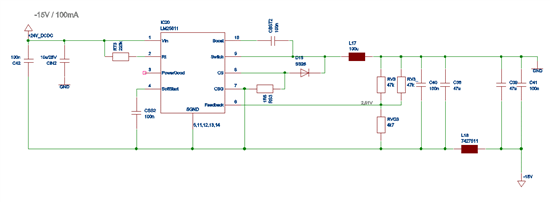Hello,
in my application i need a 5V/1,5A, a 15V/0,2A and a -15V/0,1A supply from 24VDC. As it is desireable to use the same ic for all 3 voltages, i decided the LM25011 would be a good choice. The buck configuration for +5V and +15V works perfect. However the ics used for buck-boost get killed immediately. I refered to http://www.ti.com/lit/an/slyt286/slyt286.pdf and ended up with the following schematic.
All capacitors are ceramic types, L18 is a ferrite bead. The frequency is close to 2MHz but the timing is well within constraints. A quite large inductor is used because of the small currents.
When powered the ic is getting very hot and afterwards impedances seem not to be very low but i can measure a diode voltage (vf) of 1,4V antiparallel to the catch diode (which i have changed with no effect). When i change the LM25011 it's gone until power is applied. I also unsed a 24V source with current limiting set to 100mA, but also the ics get killed immediately.
Anyone uses the LM25011 in buck-boost configuration? Any suggestions? Thank you very much.
Stefan


